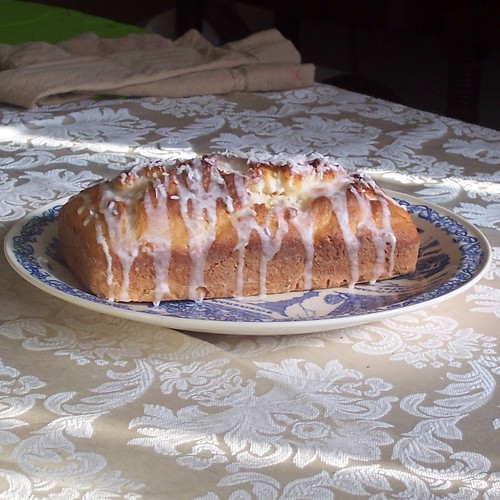Last Saturday was her 181st birthday, and, as I threatened, I made the cake.
The original recipe, as you will probably not remember, was this:
1 cup cocoanutHarder to read in the photograph reproduced with the story was this note:
2 cups flour
1 cup sugar
1/2 cup butter
1/2 cup milk
2 eggs
1/2 teaspoonful soda
1 teaspoonful cream of tartar
This makes one half the rule-–which could mean many things, but in this case seems to mean it makes enough batter for a loaf cake, or only one layer of a layer cake. If you want to make a layer cake, you'll need to make two. I used two smaller loaf pans
The cream of tartar (an acid) and the baking soda serve as leavening. Baking powder as we know it was not widely available in the U.S. until after the Civil War, and even then was apparently not really widespread until the 1890s. The baking soda and cream of tartar could be replaced with modern baking powder, but some modern baking powders use aluminum compounds (most commonly sodium aluminum sulfate and sodium aluminum phosphate) instead of cream of tartar as the acid component. Some people find the aluminum salts leave an unpleasantly chemical taste in baked goods. Baking powder also has an unfortunate tendency to expire (usually when I need it most) whereas cream of tartar and baking soda, stored separately, last much longer.
In short, I recommend the cream of tartar and soda.
As for the coconut, I used unsweetened dried coconut flakes, partly for preference and partly because I suspect sweetened coconut flakes were also not available in 19th-C Amherst. Because the flakes are dry (read: straw-like), I soaked them in the milk for about a half hour before I started making the cake. If you mix the milk and coconut about the same time you set the butter out to soften, that should be fine.
Last note: all ingredients at room temperature when you start, please. That includes the eggs.
Preheat oven to 350 F.
Line the bottom of a loaf pan with a piece of parchment paper. Grease and flour the pan and paper; set aside.
Combine the flour, cream of tartar, and baking soda in a bowl. Whisk thoroughly to combine and set aside.
Cream the butter and sugar together. When fluffy, add the eggs, one at a time, beating thoroughly after each addition. Add the coconut and milk (the coconut should have absorbed the milk) and beat a moment or two longer.
Beat the flour mixture into the wet ingredients about a third at a time, stopping to scrape down the sides of the bowl as needed. When the last of the flour is mixed into the batter, transfer the batter into the prepared pan and smooth it out evenly.
Bake 30-35 minutes, or until a toothpick or skewer inserted in the centre comes out clean. Place on a rack and allow to cool before turning out of pan.
Since this was a loaf cake, I didn't frost it but did glaze it -- 2 tbs milk, 1/2 cup confectioner's sugar, cook over low heat in a small saucepan until the sugar is dissolved, drizzle over cake -- and sprinkled a bit more of the coconut over top. A clever person would have toasted the coconut. An inventive person might have used coconut milk to make the glaze, too.
The finished product:

and the crumb:

Not as dense as a pound cake but not quite as fluffy as a standard layer cake, either. Other bakers who've tried this are reporting a dense, pound-cake-like texture and I don't know what to say about that, other than perhaps making two smaller loaves instead of one big one might have affected the rising.
The coconut is subtle -- almost more fragrance than flavour -- and the cake is not overly sweet. It goes best with tea, I think. Coffee would overwhelm it. The New York Times reports a tradition that Miss Dickinson and her friends would dip the cake in sherry. I did not try this (with shame I confess there was no sherry in the house) but it seems like it would be worth trying, and not just for the historical interest.
Emily Dickinson

No comments:
Post a Comment